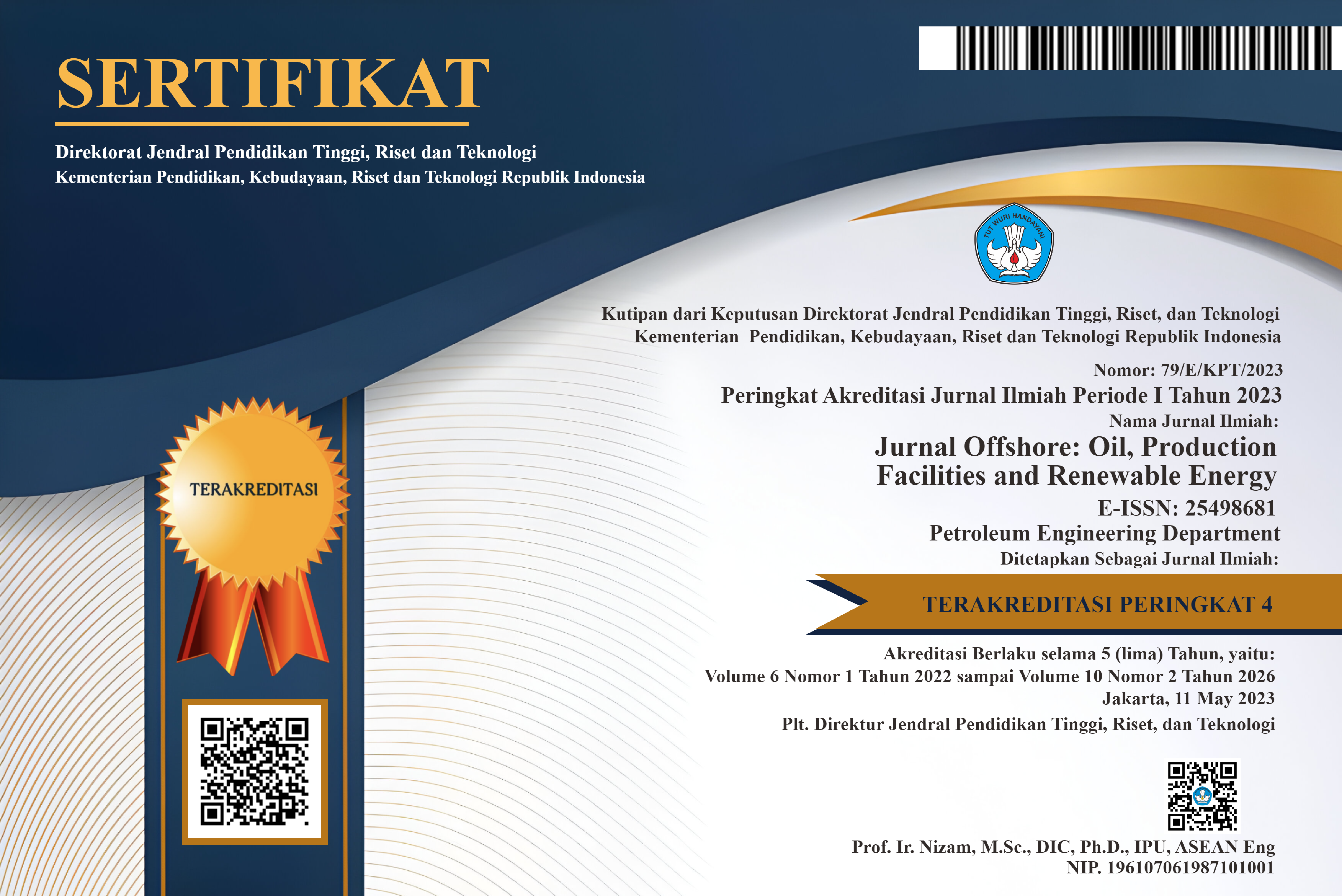Evaluasi Stimulasi Hydraulic Fracturing Menggunakan Software Mfrac
DOI:
https://doi.org/10.30588/jo.v3i1.490Keywords:
hydraulic fracturing, MFrac simulation, propprant, productivity indexAbstract
Perekahan hidraulik (hydraulic fracturing) merupakan suatu usaha untuk meningkatkan produktivitas suatu sumur dengan jalan membuat saluran konduktif bagi fluida produksi untuk mengalir dari reservoir menuju sumur. Keberhasilan dari pelaksanaan perekahan hidraulik ini dapat diketahui dari beberapa parameter. Adapun parameter keberhasilan tersebut diantaranya peningkatan permeabilitas formasi, peningkatan indeks produktivitas (PI) dan peningkatan laju produksi.Tujuan dari Perekahan hidraulik akan membahas evaluasi keberhasilan setelah perekahan hidraulik dilakukan, dimana yang menjadi acuan adalah kenaikan permeabilitas dan peningkatan laju produksi.Metodologi penelitian ini, menggunakan software MFrac Simulation dari Meyer & Associates, Inc. yang dimiliki oleh service company. Dengan memasukkan data reservoir, data lithologi batuan, data komplesi sumur, data proppant,data fluida perekah serta data-data lain yang terkait. Adapun tahap-tahap dari operasi stimulasi hydraulic fracturing ini meliputi step rate test, minifrac, evaluasi minifrac, dan main fracturing. Peningkatan produktivitas sumur terlihat sangat jelas dari hasil perbandingan productivity index (PI) sebelum dan sesudah hydraulic fracturing. Hasil perhitungan memperlihatkan bahwa dari hasil software Mfrac menunjukkan nilai PI naik 2,8126 kali lebih besar daripada PI sebelum hydraulic fracturing.
Hydraulic fracturing is an attempt to increase the productivity of a well by making a conductive channel for the production fluid to flow from the reservoir to the well. The success of the implementation of hydraulic fracturing can be seen from several parameters. The success parameters include increasing formation permeability, increasing productivity index (PI) and increasing production rates. The purpose of hydraulic fracturing will be to discuss the success of the evaluation after hydraulic fracturing is done, where the reference is to increase permeability and increase the rate of production. The methodology of this research, using MFrac Simulation software from Meyer & Associates, Inc. owned by a service company. By entering reservoir data, lithological data of rocks, well completion data, proppant data, recycled fluid data and other related data. The stages of hydraulic fracturing stimulation operations include step rate test, minifrac, minifrac evaluation, and playing fracturing. Increased productivity of the well is very clear from the results of the comparison of productivity index (PI) before and after hydraulic fracturing. The calculation results show that from the Mfrac software results show the PI value increases 2.8126 times greater than the PI before hydraulic fracturing.
References
Cahyono, M.S., 2013. Pengaruh Jenis Bahan pada Proses Pirolisis Sampah Organik menjadi Bio-Oil sebagai Sumber Energi Terbarukan. Jurnal Sains dan Teknologi Lingkungan Volume 5, Nomor 2, Juni 2013 Hal. 67-76.
Higman, C, And Van Der Berg, M. 2003. Gasification, Elsevier Science, USA.
Pranolo, H., 2010. Potensi Penerapan Teknologi Gasifikasi Tongkol Jagung Sebagai Sumber Energi Alternatif Di Pedesaan, Dalam Seminar Nasional Energi Terbarukan Indo-nesia di Universitas Jendral Sudirman Purwokerto.
Purwantana, B., An Nurisi, M., Markumning-sih, S., 2010. Kinerja Gasifikasi Limbah Padat Tebu (Saccharum Officinarum L.) Meng-gunakan Gasifier Unggun Tetap Tipe Down-draft.
Sudarsono, dkk., 2013. Pemanfaatan Limbah Se-rat Pati Organik sebagai Material Komposit Poliester. Laporan penelitian hibah bersaing Institut Sains & Teknologi AKPRIND.
Downloads
Published
How to Cite
Issue
Section
License
Authors retain copyright and grant the Jurnal Offshore right of first publication with the work simultaneously licensed under a Creative Commons Attribution 4.0 International License that allows others to share (copy and redistribute the material in any medium or format) and adapt (remix, transform, and build upon the material) the work for any purpose, even commercially with an acknowledgement of the work's authorship and initial publication in Jurnal Offshore. Authors are able to enter into separate, additional contractual arrangements for the non-exclusive distribution of the journal's published version of the work (e.g., post it to an institutional repository or publish it in a book), with an acknowledgement of its initial publication in Jurnal Offshore. Authors are permitted and encouraged to post their work online (e.g., in institutional repositories or on their website) prior to and during the submission process, as it can lead to productive exchanges, as well as earlier and greater citation of published work (See The Effect of Open Access).















